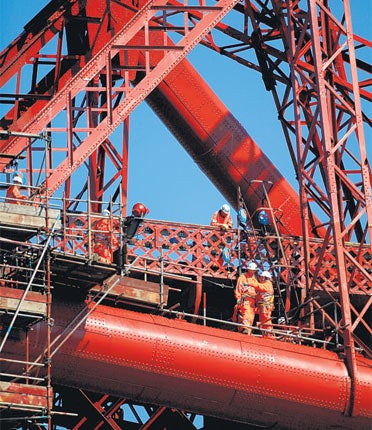When the Forth Bridge opened in Scotland in 1890, its English architects didn't know their pioneering structure would come to stand as a 20th century retelling of the myth of Sisyphus.
Like the Greek King condemned to push an immense boulder up a hill, only to watch it roll all the way down again as he neared the top, no sooner had the bridge's painters finished the job, so the story goes, than they would be required to start again.
But this new version of the myth, it was announced yesterday, is to have a happy ending. After 10 years, £130m and some extraordinary feats of scaffolding, the 1.6-mile rail bridge, which connects Edinburgh to Fife, will not require repainting for some 25 years.
So what has brought about this radical and long overdue development? A new type of paint. David Simpson, the route managing director at Network Rail Scotland, said: "The paint system being used on the bridge has been used in the past on North Sea oil rigs. We expect it to last in excess of 20 years but we will be back from time to time to maintain the most exposed sections of the structure." The project involves more than a mere application of another layer of paint. After being shielded from the environment by the scaffolding, paint tirelessly applied to the bridge over the last 120 years is being removed using an abrasive blasting technique. This work will be completed by December.
That the bridge needed constant repainting, like the tale of Sisyphus, is sadly also a myth. According to a 2004 New Civil Engineer report on modern maintenance, such a practice never existed, although under British Rail management and earlier, the bridge had a permanent maintenance crew.
In a much translated essay of 1942, the French philosopher Albert Camus caused many people to re-imagine the seemingly sad fate of the deceitful Sisyphus, punished by the gods for his deceit and avarice. "The struggle itself... is enough to fill a man's heart. One must imagine Sisyphus happy," he wrote.
Perhaps the employees of Balfour Beatty, the construction firm tasked with the repainting, feel the same way.

Join our commenting forum
Join thought-provoking conversations, follow other Independent readers and see their replies
Comments